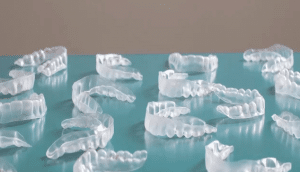With as much made up news that is around, it is important to always check your facts. This goes for just about every area—including orthodontics and dentistry.
Some of the information you have gotten about what to expect from the orthodontist (or the dentist could) very well be more fiction than fact. And sadly, many of these “stories” are the reason people neglect or even skip necessary oral health care.
Here are some orthodontic myths and dental misconceptions that commonly circulate around the magazine rack.
13 Orthodontic Myths
Myth 1: Orthodontic treatment is just for teenagers
According to the American Association of Orthodontists, adults are seeking orthodontic treatment in record numbers.
In fact, one of every five patients in orthodontic treatment is older than 21.That’s more than 1.5 million adults receiving care by an AAO-certified orthodontist each year. So if you are an adult considering braces, rest assured that you are far from alone. In fact, in our practice, about 30% of our patients are adults.
Myth 2: Orthodontic treatment takes many years
Modern advances in technology have accelerated the average length of orthodontic treatment. Not only is the time spent in braces far shorter than in past decades (with the average patient spending 1-2 years in braces), treatment is also much more comfortable due to technological advances.
 Myth 3: Receiving orthodontic treatment means metal braces
Myth 3: Receiving orthodontic treatment means metal braces
Today, metal braces are just one among many options for orthodontic treatment. Several less conspicuous alternatives exist, such as:
- Incognito (lingual braces that go on the backs of teeth),
- Invisalign (clear plastic trays or aligners),
- ceramic braces (which are less visible than metal braces).
Though some people prefer the traditional look (and even like to jazz it up with colored rubber bands around their brackets), if you don’t want people to know you are wearing braces, no one has to … we’ll help you keep it a secret.
Myth 4: Only wealthy people can afford orthodontic treatment
It is true that some options for braces are more expensive than others, and that price may increase with the complexity of your case.
However, it is far from true that only folks with money can have perfect smiles. If you have dental insurance, you might be surprised at how much of your orthodontic care is covered under your policy. Call your insurance company to discuss your coverage options. Some Health Savings Accounts can be used towards orthodontic solutions, too.
When you visit Orthodontic Associates, ask about our flexible payment plans and our different orthodontic treatments. Getting our patients the smile they have always wanted is more than just a job for us.
Myth 5: My general dentist offers braces, so they are an orthodontist
You may have heard about people applying their own braces, or even about some dentists who will perform some alignment work.
However, the fact is that orthodontists are dentists, but not all dentists are orthodontists. In fact, just 6% of dentists successfully pursue this advanced specialty that requires two to three years of training after dental school.
An orthodontist is a dentist who has gone on to receive specialized training and develop expertise in the field of orthodontics. And there is a reason there so much training is required.
Performing orthodontic treatment on yourself—or even seeking it from someone who is only partially qualified—can permanently damage your teeth or even endanger your health.
Myth 6: Regular office visits are not necessary to straighten teeth
It is true that the technological advances of modern-day orthodontics can help to make adjustment visits less frequent.
However, it is not true that you can have the braces put on, and then return to have them removed a year later.
Make no mistake, visits are a vital part of your treatment plan. Your orthodontist has to make sure your treatment is progressing according to plan. Appointments can include new wires, the addition of elastics (in some cases) for bite correction, or even bonding additional brackets when needed.
Without these regular adjustments, and if the patient is not following the plan, it can result in longer treatment times—which nobody is ever excited about.
Most patients will need to schedule appointments every six to eight weeks.

Myth 7: Orthodontic treatment and braces are purely for cosmetic purposes
Having a perfect smile will no doubt improve your selfie life, but it has farther reaching benefits than your Instagram game.
Misaligned teeth or jaw bones can cause overcrowding in the mouth, which can lead to tooth decay, headaches, earaches, difficulty biting and chewing, speech impairments and jaw inflammation.
Straighter teeth and aligned jaws have far-reaching psychological benefits, too, helping people conquer depression and social anxiety.
Myth 8: There’s almost nothing you can eat if you’re wearing braces
It’s definitely true that eating certain foods increases the likelihood of breaking a wire or a bracket, which will cause more visits to the office and slower treatment times.
However, it’s far from true that your diet is restricted beyond reason when you’re wearing braces.
There are a lot of foods that you can eat with braces and many websites that offer braces-friendly recipes. There are even cookbooks that are entirely filled with recipes designed for people wearing braces. So don’t worry about having a lack of food options during the treatment period. You might have to skip bubble gum for a while, but it’ll taste much better with straight teeth.
Myth 9: Once the braces are off, treatment is finished!
Sadly, this one is also untrue.
Getting your braces off, as exciting as it is, does not mean the end of your orthodontic treatment.
In fact, where braces end is where the most important part begins.
The next phase is called retention, and it is a critical follow-through stage that holds your teeth in the proper position—and even continues to make small corrections in some cases.
You and your orthodontist can discuss several options for retention treatment, including permanent retainers and removable retainers. The great news is that if you follow your orthodontist’s instructions after he removes your braces, your new and improved smile will last a lifetime if you wear your retainers well.
Myth 10: Wearing braces is extremely painful
Yes, it is true that the forces used in creating the smile you have always wanted and a better bite will cause SOME discomfort. It is usually in the first week once the braces are applied, and then 2-4 days after your orthodontist adjusts your braces are adjusted.
However, this discomfort is generally mild, and mostly occurs when you put pressure on your teeth.
Over-the-counter (OTC) pain medication and eating a soft food diet will help to minimize or eliminate any pain. In fact, wearing braces is now more painless than it has ever been.
Myth 11: If braces aren’t painful, it means they are not working
There used to be some truth in this. But thanks to advancements in the materials used to construct braces and the methods of adjusting them, significantly less discomfort is involved in the treatment.
In fact, some patients will not feel any pain. So there’s no cause for alarm if you don’t feel any changes in your mouth after orthodontic appointments—just consider yourself lucky!
Myth 12: Braces will set off metal detectors in security lines
Great news: you don’t have to give up airline travel or skip your court date because you are wearing braces!
The metal alloys used to make braces are so light, they will not trigger security systems in the airport or anywhere else. They also have zero effect on your likelihood of being struck by lightning or otherwise electrocuted.
Myth 13: You must brush your teeth constantly wearing braces
One of the most common concerns we hear about from first-time braces wearers is about how often they will need to brush their teeth.
Many new wearers—especially teens—have nightmare scenarios in their minds of having to brush their teeth at all times, everywhere they go. Well, there is no way around the fact that brushing your teeth while you are wearing braces is one of the most important habits you can practice.
However, it is not as dreadful as you may think.
You brush your teeth while wearing braces at generally the same frequency as you brush your teeth when you’re not wearing braces. It’s still important to brush and floss thoroughly twice a day, while, if possible, brushing after each meal (rinsing at a minimum).
8 Dental Misconceptions
Most people don’t look forward to going to the dentist. The dental industry, in general, has a bad rap. Perhaps clearing up some common misunderstandings about the dentist will help you feel more at ease about your next regular checkup. Or perhaps it won’t …

Myth #1: All teeth can easily be whitened
If you’ve watched commercials for over-the-counter whitening products, it probably seems to you that tooth whitening is a simple process that can easily be accomplished at home for a relatively low cost.
However, several factors go into how much whitening potential your teeth have, and it starts with your enamel. The natural color of your teeth is yellow, not white. If your layer of enamel is thin, then you’re going to be hard-pressed to get a bright white color.
Additionally, whitening potential depends on the nature of the stain. Some stains respond well to whitening or cleaning, and others just don’t. And all stains are going to respond better to a more expensive, professional cleaning than a DIY tray from a drug store.
Myth #2: You don’t need to see a dentist if your teeth feel fine
Tooth decay is typically painless, especially at its early stages. The same can be true of gum disease.
It is important that you receive regular checkups so that any problems can be corrected at an early stage of development. And, even if none are present, preventative dentistry is important so that no problems develop in the future.
Most dentists recommend that patients receive two cleanings per year, but those with a history of dental issues may need to go back every 3-4 months.
Myth #3: Hard-bristled toothbrushes clean teeth better
Applying extra force to the teeth does not necessarily mean that your teeth a better outcome, and can, in fact, erode the enamel faster, which can make the teeth more vulnerable to decay. Soft-bristled toothbrushes are actually the safest and most effective to use on your teeth.
Myth #4: Vigorous tooth brushing cleans teeth better
See above myth. The truth is that pressing with a lot of force and speed against your teeth and gums can be quite hard of them, leading to the erosion of both.
 Myth #5: If your gums bleed, you should stop flossing
Myth #5: If your gums bleed, you should stop flossing
This is probably one of the more frustrating myths for dental and orthodontic professionals. If your gums bleed as a result of flossing, it’s often a sign that you should be flossing more, not less.
Bleeding is often an indication that your gums aren’t used to being flossed, meaning you really need to pick up the pace, as flossing is one of the most important things you can do to take care of your teeth.
Bleeding gums also can be an early sign of gum disease, which, if you are developing, you need to adopt the habit of flossing now more than ever.
Myth #6: I should just wait for my toothache to go away on its own
Unfortunately, a toothache is often a sign of an infection, and an infected tooth can actually lead to a medical emergency down the road if it gets left untreated over a long period of time.
If you have a toothache that lasts more than a day or two, you need to see your dentist. You might need to get a filling and/or a prescription for an antibiotic medication. The dentist might also be able to prescribe you an oral or topical medication to help with the pain while the infection is healing.
Myth #7: Going to the dentist is going to hurt!
Despite the bad rap that the dentist has, your dental checkup should be a painless event! Especially if your mouth is healthy. Nothing about a regular cleaning and routine exam should cause any pain or discomfort.
In fact, just about all procedures that take place in a dentist’s chair are mostly or totally painless. Even procedures that would cause pain are rendered painless due to highly effective numbing agents. You might feel some pressure, movement or tugging, but no actual pain. Typically, the anxiety patients have about dental procedures is far worse than their actual experiences.
Myth #8: Dental Issues Like Periodontal Disease Only Happen to “Old People”
The next time you feel like skipping a round of brushing, flossing or rinsing or skipping out on a regularly scheduled checkup, be very careful of falling susceptible to these dangerous beliefs. One of the dangers, in fact, is that the majority of people believe that gum disease does not develop until the late 30s or early 40s, coupled with the fact that when gum disease does develop in young adulthood, it is often asymptomatic.



 Myth 3: Receiving orthodontic treatment means metal braces
Myth 3: Receiving orthodontic treatment means metal braces Myth #5: If your gums bleed, you should stop flossing
Myth #5: If your gums bleed, you should stop flossing
Teeth Aligners
Wow, what a great article about Orthodontic, Braces And Dental Myths, which I think is very unique. So, thanks for sharing it with us.